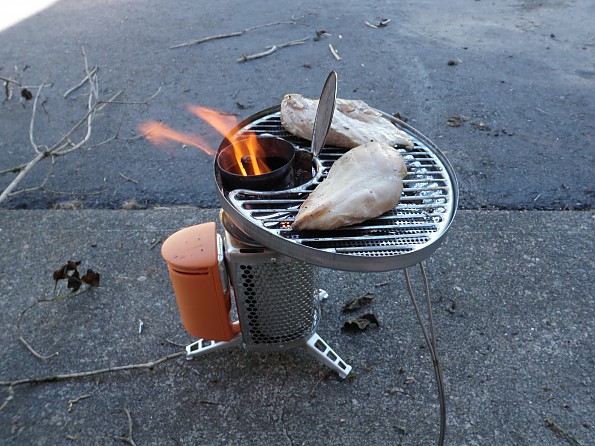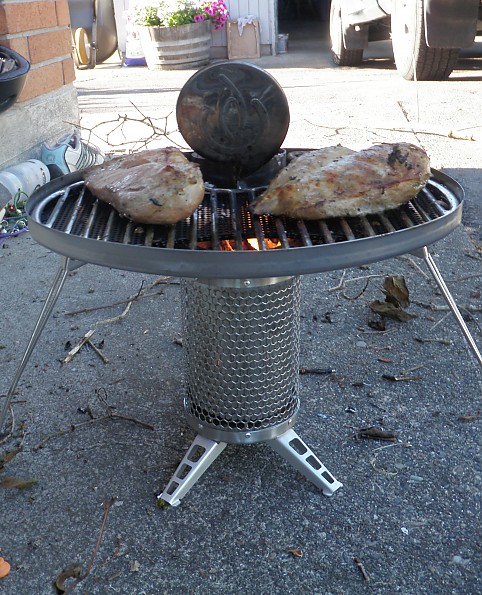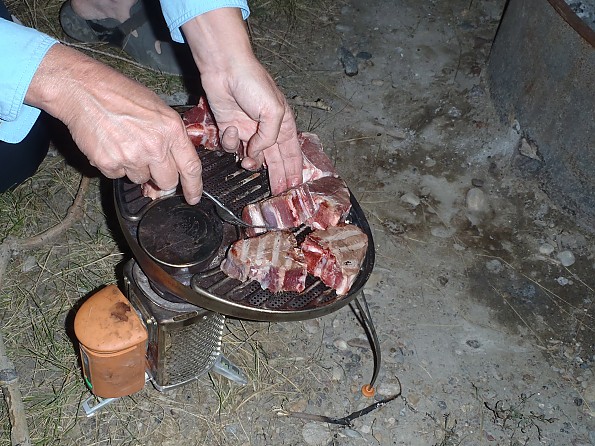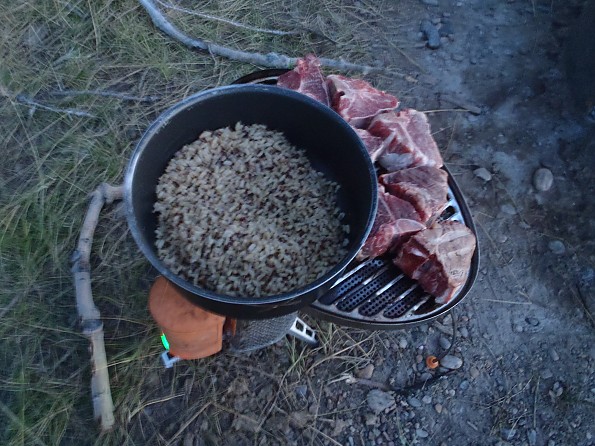BioLite CampStove Grill

The grill is a great feature of the Biolite CampStove. It's simple to use once one has learned how to maximize the way the grill works and heats. The grill makes a great base camp/tailgating/car camping grill.
Pros
- It uses bio fuel
- The grill can be loaded without interrupting heating
- It can be ready to use in 5-10 minutes of lighting
- Cover doubles as cutting board or plate
- Can heat something in a pan while grilling
Cons
- Grill has definite hot and cool spots
- No lid, so it is affected by wind
- The filling lid is not level, making using a pan a little tricky while griling
The grill is specifically designed to be used with the BioLite CampStove. Once the stove is operating and hot, the grill is a cinch to use.
Just place the grill on the stove properly, allow to heat, and grill away.
BioLite says that the grill has three zones — high, medium, and low, and that it will hold up to four hamburgers and six hotdogs.
The trick is learning how to use those zones to your advantage. This grill is not like a typical grill surface that has relatively even heating beneath. Because the grill is driven by the BioLite stove, and the flame stays stoked by a circulating fan, the grill reflects that design because the flame and heat get moved in a circular fashion in the firebox, naturally making the heating surface uneven.
On the right, with the power cell closest to the user, is the hottest area. Thus, the far left upper corner is the coolest. With some practice, flipping and rotating the food around the heat areas produces well cooked, tasty food.
But that is the rub. This is not a grill one can toss food onto and just walk away. With the uneven heating surface, one must stay pretty focused on watching the food and rotating it around the grill top to achieve the desired results.
Steak and lamb were pretty easy to do on the grill, but I like my red meat pretty rare.
However, chicken and bratz took awhile. The wind slowed down the grilling, and obviously it is important to get chicken cooked thoroughly; I also like my bratz with a crisp skin.
The chicken took a long time to cook. It was completely thawed, but it was a bit breezy. From start to finish, it was about 45 minutes to grill. These are big cutlets, but I had to really watch the meat and move it around the heat zones for even cooking.
Because the stove needs constant attention, the grill suffered the same issues of smoke as the stove, which may impact the flavor of the meat. Keep that in mind if the biofuel isn't the type of flavor one wants imbued in the meat.
One way I circumvented the smoke/flame issue to produce more even heat for the grilling was to use briquets. I bought the match light variety because of my canoe trip. I found it did produce more consistent, even heat versus the flame up/die out cycle of using wood. However, because it was match light, I did have some of the lighter fluid tinge in the meat if I needed to feed the grill more charcoal.
I pushed the grill to capacity our first night of canoeing. We brought a large package of lamb chops. They all *just* fit onto the grill. But the grill, once I learned how the grill top worked, did a good job of cooking the chops. I again, just had to pay attention to what I was doing, but the briquets gave me a little elbow room to not watch the grill every moment. I just needed to routinely shuffle the meat around the grill top. Once I got the hang of that, it was fine. The chops were some of the best I have ever eaten.
Once I got the meat going, and the firebox good and stable, I was then able to heat up the rice and quinoa side dish over the fire box feeder hole.
In fact, the shape/design of the feeder hole in the grill is a nitpick with me. with a little redesign, using the pot and grill together to make a full meal would be easier. The grill has a heat adjuster -- by closing the door to the feeder hole, the grill increases heat output. But for those making a two course (or more) hot meal, a simple re-tooling of that feature would make using the pan better. The way it is currently designed, it's a tight fit to put a pot on top behind the heat flap, and the feeder hole is at a slant.
The grill is a 3-part design. The base has the feet and sits on top of the stove. The diffuser that helps spread the heat sits inside, and on top of that is the grate. The grill comes apart easily, and cleans up pretty well. And if one is not able to do deep cleaning in the field, the grill comes with an excellent cover that not only goes over the top, it also caps the bottom opening so nothing spills out. FYI, I never had trouble cleaning the grill in the field.
Per BioLite's website:

Cooking Area 55 sq inches
Folded Size 9.5 x 12 x 3.5 inches
Unfolded Size 9.5 x 12 x 10.5 inches
Weight 1.875 lbs
Fuel Solid biomass. For use with BioLite CampStove only.
In the box BioLite Portable Grill
Instructions Manual + Grill Cover
I would add that the cover also weighs 6 ounces, so the entire unit comes in at around 36 ounces. So with the stove, it's nearly 5 pounds, total.
The grill folded down reasonable well. It fit into a gear box for my canoe comfortably. The grill felt really stable and quite well made. Even with 8 lamb chops and a pan full of rice, the unit never felt wobbly.
I trialed the grill at home, and then used it several times while on an 11-day canoe trip in August in Montana. Honestly, the grill is my favorite feature of the BioLite stove. Being able to grill simply added a wonderful feature to the canoe trip. We were able to take an ice chest, and splurge on red meats and bratz in our backcountry menu.
The grill "makes" this stove a complete package. I would probably not take the 5 pounds of product backpacking unless it was a short, special trip. But for basecamping, tailgating, canoeing, horse camping, etc where weight is not as much of an issue, this is a great product. In fact, I think it's the perfect complement to canoe cooking because both the stove and grill pack down reasonably well, and the stove/grill adds an easy way to expand a menu.
Source: received for testing via the Trailspace Review Corps
(Sample provided by BioLite for testing and review)
Greatly improves the usefulness of the BioLite CampStove 2. Tricky to get the heat right. Use aluminum foil as cover to retain heat.
Pros
- Cool design
- Make BioLite CampStove more useful
- Comes with a plastic travel cover
Cons
- Heavy
- Large to pack
Tips:
- use aluminum foil to cover food and keep heat in around meat
- don't use dish soap to keep soot off—makes food taste odd
- add lightweight tongs and a lighter to your stuff sack
Source: bought it new
Easy to use but impractical size and weight.
Pros
- Multiple heat zones
- Cooks great
Cons
- Heavy
- Bulky
Cooks great food, but of its weight and bulkiness it is impractical to go on long hikes and camping trips. It is also hard to cook multiple things because of its small surface area.
That being said, however, I love cooking on it and it gives food a taste even charcoal can't produce. Great product.
Source: received it as a personal gift
Your Review
Where to Buy
You May Like
Specs
| Price |
Current Retail: $42.96-$59.95 Historic Range: $41.97-$59.99 |










